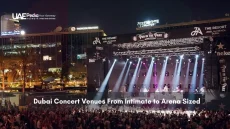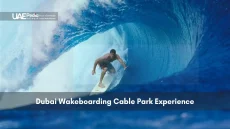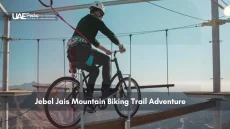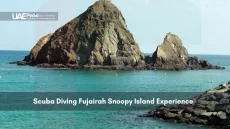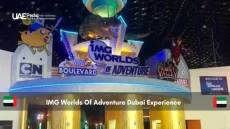What if we told you a single city hosts over 60 galleries showcasing everything from Bedouin textiles to AI-generated installations? The Emirates’ creative pulse beats louder each year, blending desert traditions with tomorrow’s tech. This isn’t just about hanging paintings—it’s where heritage whispers through calligraphy and innovation shouts from augmented-reality displays.
New gallery openings, pop-up shows in repurposed warehouses, and interactive digital experiences now dot the calendar. From Dubai’s neon-lit districts to Abu Dhabi’s curated cultural hubs, creators from Riyadh to Rotterdam collaborate here. You’ll find sculptors welding recycled metals beside hologram artists—all under one sun-baked sky.
This guide unpacks the must-see events and hidden gems across the region. We’ll explore how local traditions shape futuristic works and where to catch rising stars before they go global. Consider this your backstage pass to a scene that’s equal parts souk spice and satellite ambition.
What you’ll discover:
- Why this year’s exhibitions blend ancient craftsmanship with VR
- How emerging spaces are redefining cultural exchange
- Upcoming shows offering hands-on workshops and artist talks
Exploring the Vibrant UAE Art Scene
Every brushstroke here tells two stories: one dipped in saffron-hued traditions, another glowing with algorithmic precision. Wander through Dubai’s industrial-chic districts, and you’ll catch the scent of frankincense mingling with 3D printer resin—a sensory preview of the region’s artistic alchemy.
Threads That Weave Worlds Together
Local creators are master jugglers, balancing ancestral techniques with global currents. At Alserkal Avenue, a sculptor might transform recycled fishing nets into kinetic installations while a digital artist projects AI-rendered sadu patterns onto warehouse walls. “We’re not erasing history—we’re writing new chapters in invisible ink,” notes a curator from the space.
| Aspect | Traditional Influence | Modern Twist | Example |
|---|---|---|---|
| Materials | Palm fronds, clay | 3D-printed bioplastics | Date palm sculptures at Tashkeel |
| Patterns | Henna designs | Algorithmic generative art | Digital henna projections at Jameel Arts Centre |
| Storytelling | Oral histories | AR-enhanced installations | Interactive pearl diving exhibits |
Global Conversations, Local Accents
Galleries buzz with dialogues between middle eastern aesthetics and international trends. In Abu Dhabi, you might find Emirati photographers collaborating with Berlin-based sound artists to reinterpret desert soundscapes. These partnerships birth exhibitions where calligraphy dances with motion sensors, responding to viewers’ breath.
“Our exhibitions act as cultural bridges—each piece a passport stamp between worlds.”
Upcoming shows promise even bolder experiments: think augmented reality tours through reconstructed Bedouin tents or workshops where you’ll code generative patterns inspired by ancient pottery. The magic lies in these juxtapositions—where a grandmother’s embroidery becomes augmented reality coordinates, and coffee grounds shape futuristic clay bodies.
Spotlight on UAE Art Exhibitions
Step into a converted shipping container, and suddenly you’re tracing constellations mapped onto camel saddles from 1923. Galleries here thrive on these jarring juxtapositions—centuries-old weaving techniques framed by blockchain authentication displays. Let’s unpack what makes these displays magnetic.
At Tashkeel, one current exhibition pairs palm-frond sculptors with AI poets. Visitors watch artisans twist dried leaves into geometric forms while algorithms generate verses inspired by their movements. “It’s not just about the final piece,” explains a curator. “We’re showing the conversation between hand and code.”
| Aspect | Heritage Roots | Contemporary Edge |
|---|---|---|
| Materials | Natural dyes | Glow-in-the-dark resins |
| Techniques | Hand-stitching | 3D laser etching |
| Storytelling | Oral histories | QR-linked audio diaries |
Over in Sharjah, a pop-up space reimagines spice-trading routes through scent-based installations. You’ll sniff cardamom while watching holographic dhows crash through projected waves. These shows don’t just display objects—they build bridges between your senses and the region’s layered past.
Newer galleries take bigger risks. One warehouse exhibit lets you walk through a life-sized embroidery hoop, threads glowing with motion-activated LEDs. Another invites guests to “hack” digital calligraphy using gesture controls. The thrill? Seeing which patterns your flailing arms accidentally create.
“Our spaces are living labs—every visitor becomes part of the experiment.”
Mark your calendar for three can’t-miss displays this season. Each proves tradition isn’t being preserved—it’s being recharged, one interactive canvas at a time.
Dubai’s Iconic Art Dubai Fair Experience
Imagine sunlight bouncing off Madinat Jumeirah’s wind towers as you step into a maze of creativity spanning 40+ countries. Art Dubai transforms this waterfront gem into a global crossroads each March, where desert light meets neon projections and whispered deals. You’ll find more than an art fair here—it’s a tactile playground where traditional craftsmanship collides with blockchain-certified NFTs.
Curated Sections and Global Talent
Four distinct zones guide your journey. The Contemporary section spotlights rising stars from Lagos to Jakarta, while Modern unveils 20th-century Middle Eastern pioneers. New this year: Digital Campus, where VR headsets teleport you to AI-generated oases. “We’re not just displaying work—we’re hosting dialogues between generations,” explains a lead curator.
| Section | Focus | Medium | Artists Featured |
|---|---|---|---|
| Bawwaba | Social impact | Mixed media | 25+ Global South creators |
| Digital Campus | Tech-driven works | VR/AR installations | Pioneers like Refik Anadol |
| Modern | Regional masters | Paintings & sculptures | Dia Azzawi, Mona Saudi |
Interactive Installations and Digital Arts
Touch-responsive walls let you “paint” with your shadow at one installation, while another uses facial recognition to morph your features into abstract patterns. The real magic? Watching grandparents laugh while manipulating holographic calligraphy via hand gestures.
Practical magic: Mark March 1-3, 2024 on your calendar. Early bird tickets drop in January, with weekend passes granting after-hours access to live performances. Whether you’re hunting emerging talent or just want to play with light sculptures, this art fair delivers brain-tickling wonder.
Alserkal Art Week: A Celebration of Contemporary Art
Cement floors vibrate underfoot as welding sparks fly between conversations in six languages. Alserkal Avenue’s industrial warehouses burst into a creative supernova during its annual art week, where steel beams frame radical ideas and espresso machines hum alongside power tools. This isn’t just an exhibition—it’s a five-day cultural ecosystem where you might stumble upon a robotics engineer debating textile traditions with a Bedouin poet.
Innovative Exhibitions and Panel Discussions
This year’s programme crackles with boundary-pushing concepts. Pakistani artist Imran Qureshi’s “Vanishing Points” reimagines Mughal miniatures through shattered mirrors, while panel debates dissect topics like AI’s role in preserving oral histories. “We’re creating collision zones,” says a programming head. “Where else can you watch a calligrapher duel a graffiti bot?”
Workshops, Screenings, and Live Performances
Roll up your sleeves for hands-on sessions: code generative patterns using date palm algorithms or stitch LED threads into traditional textiles. Nightfall brings film screenings in repurposed shipping containers and jazz improvisations fused with Emirati percussion. Local and international artists collaborate on installations that morph daily—today’s sculpture becomes tomorrow’s performance stage.
The real magic? Seeing bankers and schoolkids alike laughing as they manipulate holographic sand art. Whether you’re hunting thought-provoking contemporary art or just want to taste-test tomorrow’s trends, this art week turns passive viewing into active participation. Pro tip: Wear comfortable shoes and arrive hungry—the best conversations happen near the food trucks.
An Intimate Look at On Second Thought: The Warehouse Show
The scent of freshly ground coffee mingles with oil paint as you step into this converted storage space. On Second Thought: The Warehouse Show thrives on raw edges—exposed brick walls framing vibrant chaos, mismatched armchairs inviting deep conversations beneath dangling Edison bulbs. Here, emerging creators share walls with established names, their works whispering secrets only bold spaces allow.
Seth P. Benzel’s abstract paintings dominate one corner, their swirling ochres and cobalt blues stretching taller than most visitors. “These aren’t just colors on canvas—they’re weather systems,” laughs a regular. The artist layers textures like geological strata, each brushstroke capturing fleeting moments between creation and decay.
“We’re serving creativity espresso-shot style—strong, unfiltered, and best enjoyed slowly.”
Monthly rotations spotlight new voices. Last week’s star: a mixed-media artist weaving palm frond patterns into augmented reality projections. This Thursday brings a textile designer coding LED threads to pulse with live oud music. The magic? Watching baristas steam milk beside installations that morph with sunlight.
Three reasons to visit:
- Discover tomorrow’s names today in a space that feels like your coolest friend’s loft
- Taste cardamom lattes while dissecting brushwork techniques with creators
- Witness how café chatter becomes part of the works—sound-responsive walls shift hues as conversations crescendo
Come hungry for inspiration and baklava. Leave with paint under your nails and the sense that art isn’t something you view—it’s what happens when life spills onto canvas.
Uncovering Local Narratives: Bayt Mamzar and Rooms For Error
Tucked between spice souks and falcon markets, a weathered villa hums with stories etched in peeling paint. Bayt Mamzar’s gallery space thrives in this historic Dubai neighborhood—think creaking staircases and courtyard shadows that whisper tales of urban transformation. Here, the “Rooms For Error” exhibition pulses with kinetic energy, its mixed-media installations mirroring the city’s dance between rapid growth and quiet resistance.
Walk through suspended metal sculptures that clang like construction sites, then pause at video diaries of residents navigating ever-changing streets. One piece layers projected family photos over bulldozed lot coordinates—a digital scrapbook of disappearing landmarks. “We’re mapping memories before they become mythology,” explains a participating creator.
“These spaces aren’t neutral containers—they’re active participants in the stories we tell.”
Community-driven dialogues fuel both venues. At Rooms For Error, performance artists reinterpret demolition notices as poetry while visitors stitch fabric fragments from demolished homes. The raw intimacy disarms—you’ll debate urban planning with strangers over karak chai, surrounded by installations that breathe with the neighborhood’s heartbeat.
Three reasons these spaces matter:
- Bayt Mamzar’s arched windows frame unvarnished narratives often overshadowed by glossy high-rises
- Rooms For Error turns construction debris into poignant commentary on impermanence
- Both venues host weekly story circles where creators and locals co-develop projects
Come for the thought-provoking works. Stay for the humbling realization that every peeling wall and rewired circuit board holds chapters of a living city’s diary.
Gulf Photo Plus: Remembering Through Photographic Art
Light leaks through blackout curtains onto prints still damp from the darkroom. At Gulf Photo Plus, shutter clicks mix with the hum of archival scanners—a symphony of past and present colliding. This Dubai hub has shaped the region’s visual storytelling since 2005, its walls bearing witness to revolutions of both lens and society.
Majd Arandas’ current exhibition transforms the space into a time machine. Her series layers family snapshots over satellite images of erased neighborhoods, each print a palimpsest of personal and collective memory. Visitors navigate the gallery like archivists, piecing together fragments of lives lived where glass towers now stand.
| Theme | Technique | Emotional Impact | Example |
|---|---|---|---|
| Memory Layers | Archival image blending | Nostalgia meets urgency | 1950s family portraits overlaid on modern city grids |
| Silenced Voices | Infrared film processing | Haunting absence | Faded letters projected onto abandoned buildings |
| Urban Transformation | Interactive light tables | Tangible loss | Viewers rearrange demolished home blueprints |
One wall stops visitors mid-step: blown-up negatives show hands clutching vanished house keys, their metallic glint echoing Dubai’s skyline. “We’re not just displaying photos,” explains the curator. “We’re asking viewers to become witnesses—to touch the fingerprints history leaves behind.”
“Every click freezes a moment, but our exhibitions reveal how those moments keep breathing through time.”
The installation’s centerpiece lets guests layer their phone photos over archival street scenes. Watch your morning coffee shot merge with 1973 market bustle—suddenly, you’re both documentarian and subject in Dubai’s unfolding story.
Three reasons this space matters:
- Pioneered film development workshops during the digital photography boom
- Hosts monthly critique circles where amateurs debate techniques with pros
- Arandas’ show includes a soundscape of recovered cassette tape recordings
Come ready to question what survives when cities reinvent themselves weekly. Leave understanding that cameras don’t just capture light—they preserve the shadows too often cropped from the frame.
The Promise of Middle Eastern Art at Zawyeh Gallery
Walls here speak in layered dialects—acrylic whispers ancestral tales while mixed media shouts modern dissent. Zawyeh Gallery pulses with stories often unheard, its white cube space transformed into a stage for eastern artists wrestling with identity, displacement, and hope. “We’re not just hanging paintings,” says a curator. “We’re stitching torn maps back together with threads of memory.”
Current group exhibitions crackle with urgency. Palestinian creator Bashir Makhoul’s fragmented mirrors reflect splintered homelands, while Syrian textile artists weave bullet casings into wedding veils. Each piece becomes a dialogue partner—questioning what survives when borders shift faster than brushstrokes dry.
Three reasons this space matters:
- Spotlights creators from Ramallah to Beirut rarely seen in commercial spaces
- Blends ancient calligraphy techniques with augmented reality overlays
- Hosts monthly artist-led walks dissecting symbolism in real time
“Our exhibitions aren’t answers—they’re invitations to sit with uncomfortable questions.”
Don’t miss the current showcase’s centerpiece: a suspended installation of 1,001 keys collected from displaced families. Touch sensors trigger audio snippets—laughter, arguments, lullabies—turning viewers into temporary keepers of lost homes. This gallery proves that art isn’t about pretty distractions. It’s where cracked clay and pixelated protests remind us whose stories still demand telling.
The Enchanting Fusion of Past and Future at 1×1 Art Gallery
Time folds like origami inside this white-walled space—centuries-old motifs pirouette alongside neon projections. At 1×1 Art Gallery, every exhibition feels like stepping into a conversation between ancestors and futurists. KM Madhusudhanan’s “The Shape of the Sky, A Rectangle” anchors the current show, its layered canvases echoing ancient Indus Valley seals through fractured digital overlays.
The works here thrive on contradictions. Madhusudhanan stitches colonial-era maps with AI-generated textures, creating visual palimpsests that ask: “Whose history gets preserved?” Visitors trace finger-like brushstrokes across surfaces where ochre pigments bleed into pixelated grids. It’s archaeology meets algorithms—a tactile dance of memory and mutation.
Three threads weave through the art gallery’s ethos:
- Fragmented pottery shards reimagined as 3D-printed sculptures
- Projected cuneiform scripts that morph with viewer movements
- Soundscapes blending traditional instruments with glitch effects
“We’re not just displaying objects—we’re building time machines,” explains the curator. “Each piece becomes a part of an unending dialogue between what was and what could be.”
The magic lies in the details. One installation lets you “rewrite” ancient symbols using motion sensors—your gestures become ink on digital parchment. Another pairs Neolithic tool replicas with VR headsets, transporting you to imagined Bronze Age markets. These exhibitions don’t separate past from future—they prove creativity’s thread spans millennia.
Come ready to question timelines. Leave understanding that innovation isn’t about erasing history—it’s about folding it into tomorrow’s blueprint.
Abu Dhabi’s Cultural Journey: Kings and Queens of Africa at Louvre Abu Dhabi
Time bends where golden scepters meet augmented reality displays. Louvre Abu Dhabi’s latest exhibition unfolds like a living atlas, tracing 5,000 years of African sovereignty through 300+ artifacts. Crowns forged from desert metals share walls with holographic thrones—proof that power wears many faces across eras.
Walk past a 16th-century Benin bronze leopard, its spots gleaming beside a modern sculpture of welded mobile phones. Each piece whispers secrets of leadership—from Ashanti gold weights to Swahili ceremonial robes stitched with satellite imagery. Curators here don’t just display history—they spark dialogues between ancient craftsmanship and today’s creators.
| Artifact Type | Historical Period | Modern Influence |
|---|---|---|
| Royal Masks | 12th-15th Century | Contemporary fashion motifs |
| Ceremonial Staffs | Pre-colonial Era | Public sculpture designs |
| Textile Archives | 19th Century | Digital pattern algorithms |
“We’re mapping how regalia evolves,” explains a Louvre Abu Dhabi guide. “That 3D-printed scepter? Its blueprint came from a 9th-century Mali empire relic.” The art gallery becomes a bridge—linking Ndop statues to VR throne rooms where visitors design virtual kingdoms.
Abu Dhabi’s cultural ambition shines brightest here. By hosting this exhibition, the region positions itself as a global crossroads for heritage conversations. Don’t miss the tactile displays—run fingers over replicas of Kongo nail fetishes or feel the weight of a Yoruba beaded crown replica.
“These objects aren’t frozen in time—they’re blueprints for tomorrow’s leadership aesthetics.”
Plan your visit before 2025—this journey through dynasties reshapes how we see authority’s visual language. From Ethiopian illuminated manuscripts to mixed-media installations dissecting neocolonialism, every gallery turn reveals why crowns still captivate in our digital age.
NYU Abu Dhabi’s Dynamic Exhibition: Between the Tides
Saltwater whispers mingle with digital soundscapes as you enter NYU Abu Dhabi’s latest showcase. “Between the Tides” gathers 21 creators dissecting how coastal communities navigate change—where fishing nets meet fiber-optic cables and oral histories fuse with data streams. This exhibition doesn’t just display works—it maps the tension between growth and preservation through layered sensory experiences.
Walk through a suspended maze of recycled fishing floats that hum with recorded voices. Each sphere shares stories of Emirati pearl divers and Mumbai dockworkers—a chorus of resilience against rising seas. One installation tracks real-time coral bleaching data, its projections shifting from vibrant blues to alarming reds as visitors approach.
| Theme | Medium | Interactive Element |
|---|---|---|
| Urban Development | Recycled materials | Touch-responsive city models |
| Ecological Shifts | Bio-reactive installations | Live coral growth tracking |
| Cultural Memory | Augmented reality | Projected oral histories |
Curators at NYU Abu Dhabi designed this art gallery experience as a global conversation starter. Saudi photographer Ahmed Mater contrasts Bedouin tent patterns with satellite images of expanding cities. Meanwhile, Omani artist Alia Al Farsi stitches archival trade documents into tapestries that glow under blacklight.
Practical magic: Catch this exhibition April-May 2024 at NYUAD’s downtown space. Free entry, but reserve timed tickets online. Pro tip: Attend Thursday artist talks—you’ll debate sustainable design with creators over cardamom-infused lemonade.
“We’re not predicting the future—we’re showing how communities worldwide are rewriting their survival scripts.”
Come ready to wade into urgent dialogues. Leave with sand in your shoes from the tactile shoreline installation and fresh perspectives on how the region balances tradition with tomorrow’s tides.
Public Art Abu Dhabi Biennial: Homesickness on the Corniche
Salt-kissed breezes carry whispers of pearl divers’ chants along Abu Dhabi’s Corniche—until dusk transforms the waterfront into a glowing archive. Farah Al Qasimi’s “Homesickness” installation reimagines urban space as a sensory time capsule. Her LED-lit oyster shells pulse to synthetic tides, their fractured light mirroring the Gulf’s ever-shifting identity.
This biennial turns concrete into canvas. Al Qasimi’s work nestles between joggers and date palms, its soundscapes blending vintage radio static with AI-generated waves. “Each shell holds layered memories—like the city itself,” explains the artist. Visitors touch weatherproof screens to unveil oral histories, their fingers tracing digital growth rings of coastal transformation.
Three reasons this public art abu dhabi showcase captivates:
- Recycled fishing nets form floating sculptures that sway like ancient trade sails
- Interactive projections map vanished pearling villages onto modern high-rises
- Nightly sound baths blend Emirati folk songs with algorithmic compositions
The abu dhabi biennial thrives on these collisions. Traditional motifs get remixed—a child’s sandcastle becomes augmented reality architecture, while elders share stories that trigger light patterns. It’s communal storytelling through tech, proving heritage isn’t static but a living code to reinterpret.
“We’re building bridges between what was lost and what’s emerging—every light beam’s a stitch in time.”
Plan your visit between April-May 2024. Wander at sunset when installations glow amber, then stay as constellations align with LED “pearls” beneath the Corniche. This art abu dhabi experience doesn’t just decorate the city—it rewires how we remember.
Sharjah Biennial 16: Celebrating Intergenerational Narratives
Grandmothers and toddlers share paintbrushes under the same tent at this year’s event. The 16th edition pulses with stories passed hand-to-hand across decades, blending ancestral wisdom with digital experiments. Curators designed this Sharjah Biennial as a living archive—where elders’ memories fuel tomorrow’s creations.
Artistic Commissions and Interactive Acts
One installation lets visitors stitch family recipes into augmented reality tapestries. Lebanese artist Marwa Arsanios projects oral histories onto suspended fabrics that ripple with touch. “We’re not just displaying art—we’re creating living conversations between eras,” says a participating curator.
| Element | Traditional Inspiration | Modern Approach | Audience Role |
|---|---|---|---|
| Storytelling | Bedouin poetry | AI-generated verses | Voice recordings |
| Craft | Palm-frond weaving | 3D-printed patterns | Collaborative design |
| Performance | Folk dances | Motion-sensor choreography | Movement triggers |
Workshops and Experiential Installations
Thursday mornings buzz with clay sculpting sessions led by octogenarian potters. Kids code light patterns inspired by their grandparents’ embroidery designs. These hands-on labs turn viewers into co-creators—muddy fingers and laser cutters working side by side.
The group exhibition thrives on contrasts. Yemeni photographers document resistance movements beside VR reinterpretations of ancient rituals. Each piece invites dialogue—not just about art, but how communities remember and reimagine themselves.
“This Biennial isn’t a stage—it’s a kitchen where generations cook up new futures together.”
Plan your visit before June 2025. Come for the public art installations that transform courtyards into time machines. Stay for the sunset performances where traditional drums duel with synth beats. Here, every brushstroke bridges yesterday’s whispers and tomorrow’s shouts.
Innovative Artist Commissions in Al Ain and Al Jahili Fort
Sunlight filters through ancient palm fronds, casting shadows on sandstone walls where contemporary creations now breathe new life. Al Ain Oasis and Al Jahili Fort host groundbreaking 2024 commissions that blend heritage with cutting-edge vision. These spaces transform into living dialogues between past and present.
Site-Specific Art and Cultural Heritage
Manal Mahamid’s suspended textile installation at Al Jahili Fort reimagines Bedouin weaving patterns using solar-reactive threads. By day, the work echoes traditional sadu designs. At sunset, UV-sensitive fibers glow like desert constellations. “Each thread carries ancestral knowledge while questioning material permanence,” explains the artist.
| Element | Historical Inspiration | Modern Technique | Example |
|---|---|---|---|
| Materials | Natural dyes | Photochromic textiles | Mahamid’s light-reactive canopy |
| Patterns | Oasis irrigation maps | 3D topographic modeling | Falconry perches carved via CNC |
| Soundscapes | Date harvest chants | AI-generated harmonies | Wind-activated audio installations |
These commissions reshape how we experience history. Visitors walking through Al Ain’s date palm groves encounter glass sculptures etched with fossilized pollen patterns. The pieces mirror archaeological finds from nearby UNESCO sites.
“We’re not decorating spaces—we’re creating time portals where hands can touch layered stories.”
Three reasons these works captivate:
- Stone carvings incorporate augmented reality triggers revealing oral histories
- Palm-frond installations weather naturally, documenting environmental change
- Interactive elements let visitors rearrange digital heritage mosaics
Come trace your fingers along walls where centuries-old craftsmanship meets biodegradable resins. These immersive experiences prove cultural preservation isn’t about freezing the past—it’s planting seeds for future growth.
International Art Movements and Local Art Trends
Color palettes collide where desert ochre meets Tokyo neon in today’s creative hubs. Global creators and regional makers swap techniques like secret recipes—mixing street art grit with intricate henna precision. This cross-pollination sparks works that feel both comfortingly familiar and thrillingly alien.
Modern Contemporary Perspectives and Global Exchange
At Warehouse421’s latest programme, a Polish sculptor teaches Emirati students to cast sand dunes in biodegradable resin. Meanwhile, Saudi photographers collaborate with Seoul-based holographers to reimagine ancestral portraits. These partnerships birth pieces that defy easy categorization—like AI-generated sadu weavings reacting to cryptocurrency fluctuations.
| Global Influence | Local Response | Result |
|---|---|---|
| Japanese wabi-sabi | Desert erosion patterns | Clay installations aging intentionally |
| Berlin street art | Arabic calligraphy | Spray-painted poetry murals |
| New York pop surrealism | Gulf folklore | Dreamlike date palm sculptures |
Curators call this the “third culture” effect. “When a Brazilian digital artist studies Bedouin star navigation, neither leaves unchanged,” notes a Sharjah Biennial organizer. These fusions push contemporary art beyond predictable trends into uncharted territory.
Spot emerging hybrids by watching for:
- Materials pairing ancient natural dyes with smart textiles
- Themes blending migration stories with climate tech
- Formats merging VR with tactile craft workshops
“Our world doesn’t need more echo chambers—it needs these creative collisions that rewrite cultural DNA.”
Galleries now host “idea swap” nights where international artists and local artisans trade skills. You might find a ceramicist teaching neural network scripting beside a coder mastering palm-frond weaving. These exchanges prove creativity thrives where perspectives cross borders.
Final Reflections on UAE’s Dynamic Art Landscape
Your journey through the Emirates’ creative pulse might begin with a holographic pearl diver—and end with your fingers tracing augmented-reality calligraphy. From warehouse pop-ups to Louvre Abu Dhabi’s regal displays, every artist and installation stitches new threads into the region’s cultural tapestry.
Grand fairs like Art Dubai prove innovation thrives beside tradition. Intimate spaces like Bayt Mamzar whisper narratives through peeling walls and QR-coded memories. Whether you’re decoding AI-generated sculptures or joining hands-on programmes, each experience becomes part of a larger dialogue—where heritage fuels tomorrow’s blueprints.
Three takeaways for curious viewers:
- Site-specific works transform forts into time machines
- Group exhibitions bridge global techniques with local stories
- Public art installations turn cityscapes into living archives
The world watches as this region redefines cultural exchange. Now’s your moment to dive in—book tickets for autumn’s Abu Dhabi Biennial or lose yourself in Alserkal’s neon-lit labs. Every brushstroke here writes past-present collisions into history. Will your footsteps join the dance?
Mark your calendar for March 1–3, 2024, when Art Dubai transforms Madinat Jumeirah into a global art hub. The fair’s 16th edition features curated sections like Art Dubai Digital and Bawwaba, spotlighting artists from Latin America, Africa, and South Asia.
Alserkal Avenue becomes a playground for contemporary creativity during Art Week (February 1–10). Think experimental installations like Sara Al Haddad’s textile narratives, panel discussions with Guggenheim curators, and late-night film screenings under the stars.
Absolutely! The biennial (February 7–June 11, 2024) blends art with hands-on workshops. Kids love Alia Farid’s claymation films at Kalba Ice Factory, while adults dig into historical re-examinations through Al Zubair’s Omani coffee rituals.
This groundbreaking show (until July 21, 2024) pairs 19th-century African royal artifacts with modern works by artists like Omar Victor Diop. It’s a visual dialogue between ancestral masks and contemporary photography—perfect for history buffs and design lovers.
A>Homesickness isn’t just a feeling here—it’s art. Until April 30, 2024, Tarek Al-Ghoussein’s mirrored pavilions and Mohammed Kazem’s GPS-triggered soundscapes turn the waterfront into an open-air gallery exploring belonging in transient communities.
Yes! This thought-provoking show (through May 25, 2024) at The Project Space is free to all. Dive into multimedia works examining Dubai Creek’s evolution—from fishing nets to 3D-printed coral reefs—without spending a dirham.




